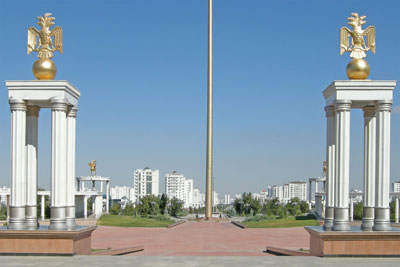Turkmenistan — dangers and annoyances
This item appears on page 23 of the March 2014 issue.
Turkmenistan was one of the “five ’Stans” that I visited on a group tour of Central Asia, Oct. 4-27, 2013. If you are planning to travel there, you may wish to take note of my experiences.
We were given advance notice that the tour director scheduled for our trip had had his Turkmenistan visa denied and that we would have a different tour director, Elena, in that, our final country before returning to the States. We also learned that another person in the group had his visa denied, so he and his wife would not be continuing on the trip with us. Elena later stated that visas were routinely denied, with no reasons given.
We had been warned that our border crossings between Kazakhstan, Kyrgyzstan, Tajikistan, Uzbekistan and Turkmenistan would be time-consuming and arduous. Our crossing from Uzbekistan into Turkmenistan was the worst, with what seemed like endless security checks, searches and invasive pat-downs.
There was a long, confusing ordeal when calculating the cost of our visas, which we were told should be bought upon entry into Turkmenistan. There was the close scrutiny of all of the American coinage I had accumulated on my outgoing stopover in New York City. Worst of all in the crossing from Uzbekistan to Turkmenistan was the mile-long walk through the several no-man’s lands, towing all our luggage, in the very windy and frigid weather.
The first full day in Turkmenistan, I was informed by Elena that the documents sent in advance of my arrival had been deemed unsatisfactory by government officials. I was promptly hauled off to a photography studio, where another set of passport photos were taken (at my expense). With your visa applications, I suggest submitting the best-quality passport photos possible.
The visit to Kunya Urgench on our first day in Turkmenistan was in very cold, windy weather. The huge, arid archaeological area contained few ancient monuments not seen in much better examples earlier in the trip.
The white-marble city that is Ashgabat, the capital, was initially impressive, with buildings all very new and very modern, then it became obvious that there were only guards, police and street cleaners on the streets.
Our centrally located hotel was one of the gargantuan marble buildings. It had an interior in a garish, nouveau riche style. It also had an eerie aura about it in that we seemed to be the only guests.
We also appeared to be the only visitors at the massive, marble-clad National Museum of History, where, in spite of paying the equivalent of $18 for a permit to photograph within the museum, I was harassed by a museum guard while photographing displays in an area leading to the museum’s shop. Little did I know that where travelers could or could not take photographs would be wide open to interpretation.
The displays within the National Museum of History were especially disappointing. Imposing showcases displayed very fragmentary archaeological remains and objects of only minor historic interest. I regretted paying the exorbitant photography fee only to find so little that I felt was worthy of being photographed.
After feeling ripped off at the National Museum, I was dismayed to find and unwilling to pay a photography fee at the open-air site of Nissa.
The day trip from Ashgabat to Mary to see the ancient city of Merv was especially depressing and disappointing and certainly not worth the hassles of undergoing all the security checks and pat-downs at the airports. I love ruins, but those at Merv and Kunya Urgench were in such bad condition that you could hardly tell what once existed. You had to use a LOT of imagination.
In fact, all three archaeological sites we visited in Turkmenistan were very disappointing: Nissa, Merv and Kunya Urgench. I found the sites in Samarkand, Bukhara and Khiva, Uzbekistan, in far better condition and much more interesting from a historic standpoint.
The most traumatic and frightening incident of my visit occurred on the second day. While waiting by the bus parked in front of our hotel in Ashgabat, I decided to photograph a few city views. Without warning, I was surrounded by three menacing policemen, who demanded that I hand over my camera, which I did. Fortunately, I wasn’t arrested, nor was my camera confiscated or destroyed.
When finally back in the bus five minutes later, I was shocked to see that all the photographs from a third of my trip had been deleted from my camera’s memory card. When I protested to Elena, she claimed that the policemen wouldn’t have known how to delete photos on my particular camera. She also maintained that she had warned us three times not to take photographs outside the hotel. I had never heard her give any such warning, however.
Elena said that, in addition to the photographing of most government buildings being off limits, the primary building near the hotel that is not to be photographed is the Presidential Palace, which, ironically, is depicted on the manat, the Turkmenistan unit of currency, not to mention being pictured on the Web in a Wikipedia entry.
While you’re in Turkmenistan, I recommend carrying your passport with you at all times, if possible, in case you’re asked for ID. (I was not.)
I certainly felt very unwelcome as a visitor to Turkmenistan. Hopefully, what I wrote will help other visitors have much better experiences.
DAVID J. PATTEN
Saint Petersburg, FL


